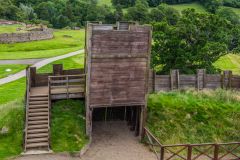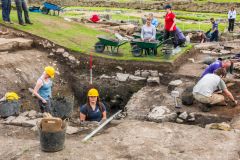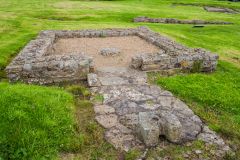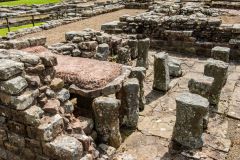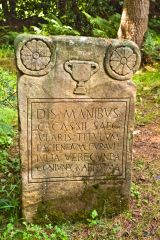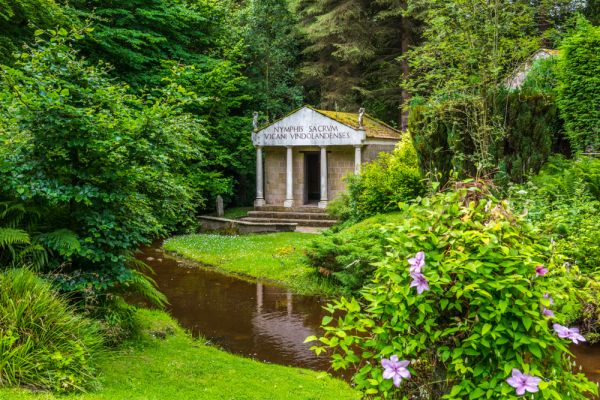
Vindolanda is a Roman fort, built sometime around AD 85 to guard the major road known as the Stanegate, which stretched roughly east to west across the top of Roman Britannia from the Solway to the mouth of the Tyne. This means that Vindolanda was in place roughly 40 years before the building of Hadrian's Wall.
Even though it predated Hadrian's Wall, men stationed at Vindolanda played a big part in its construction, and later served to garrison the Wall's defences.
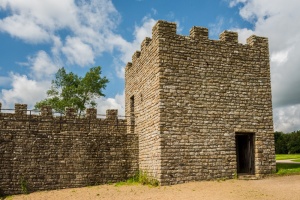
The site chosen for the fort was a farm field set on a relatively flat promontory of land, falling away steeply to streams. The steep sides of the promontory provided Vindolanda with good natural defences.
The earliest forts of timber have been very well preserved beneath a covering of turf. The timber forts were much larger than the later stone forts whose remains we can see today, and must have held a garrison of at least 1000 soldiers.
By the late 2nd century the timber forts had been rebuilt on a smaller scale in stone. As each new fort was built it sealed the preceding forts in an anaerobic layer (without oxygen). This means that each layer was perfectly preserved by the next layer, creating an extraordinary treasure trove of archaeological finds, from leather shoes to clothing.
Early Writing
The most extraordinary finds at Vindolanda are wooden writing tablets, their inscriptions beautifully preserved. The tablets are about the size of a modern postcard and are covered in ink handwriting. The writing tablets found here are the single best archive of written material in Western Europe and the earliest known written documents in Britain.
The tablets cover a huge array of situations. Some are social invitations, requests for better supplies (including more beer), and requests for time off. Several show that the Romans had insulting words for the local Britons.
A museum on the site contains an extraordinary array of finds from the site ranging from household objects, textiles, leather goods. Among the buildings on the site are a bathhouse, barracks, workshops, and temple.
The Vindolanda Trust, which operates the site, has done an enormous amount of work to help visitors understand what life was like here. There are recreations of a Roman fort, a temple, and even a section of Hadrian's Wall, as well as a Romano-British house, and a Northumbrian croft.
Vindolanda was occupied continuously from the 1st century well into the 8th century, long after the Romans themselves had left Britain. The Roman community was transformed over time into a very British one.
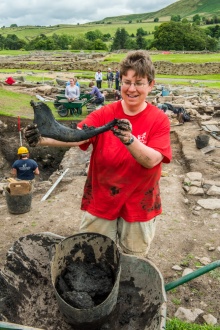
a fresh find
Watching Archaeology
At least nine forts lie atop one another at Vindolanda, and the painstaking process of excavation continues, as it probably will for over another century before the site is laid completely bare.
Each year the Trust welcomes volunteers to join in helping to excavate the site and uncover more of the history left beneath the turf at this exciting archaeological site.
It is great fun to watch the archaeologists at work. And they seem to really enjoy talking about their work with visitors. When we were watching the excavations one of the archaeologists uncovered a jaw bone of an animal from a pit, and she was happy to show it to us and explain what finds like this told the archaeologists about life at Vindolanda.
Another archaeologist took time off work to show us some of the circular foundations of huts built after the fort was founded, and explained how the fort changed and developed over the centuries. It was a wonderful insight into how experts try to uncover and interpret the past, and to see it unfolding in front of your eyes is a fascinating experience.
Visiting
Vindolanda is very well signposted off the B6318 and the A69 outside Haltwhistle. Access is by a narrow road with passing places, so do be careful of oncoming traffic.
Vindolanda is really two separate attractions in one. At the western side of the site are the fort and archaeological dig, along with recreations of both a timber and later stone towers. At the eastern side of the site are the museum, cafe, shop, and recreations of the bathhouse, temple, and croft.
You can purchase a joint ticket with Vindolanda and the Roman Army Museum, a few miles further west along Hadrian's Wall.
About Vindolanda Roman Fort
Address: Bardon Mill,
Chesterholm,
Hadrian's Wall,
Northumberland,
England, NE47 7JN
Attraction Type: Roman Site
Location: Located just to the north of the A69 near Bardon Mill, or south of the B6318 at Chesterholm.
Website: Vindolanda Roman Fort
The Vindolanda Trust
Location
map
OS: NY766662
Photo Credit: David Ross and Britain Express
POPULAR POSTS
HERITAGE
 We've 'tagged' this attraction information to help you find related historic attractions and learn more about major time periods mentioned.
We've 'tagged' this attraction information to help you find related historic attractions and learn more about major time periods mentioned.
Historic Time Periods:
Find other attractions tagged with:
1st century (Time Period) - 2nd century (Time Period) - 5th century (Time Period) - 8th century (Time Period) - Roman (Time Period) -
NEARBY HISTORIC ATTRACTIONS
Heritage Rated from 1- 5 (low to exceptional) on historic interest
Winshields Roman Wall (Hadrian's Wall) - 1.2 miles (Roman Site) ![]()
Allen Banks & Staward Gorge - 2.4 miles (Countryside) ![]()
Housesteads Fort (Hadrian's Wall) - 2.4 miles (Roman Site) ![]()
Hadrian's Wall - 2.4 miles (Roman Site) ![]()
Mare and Foal Standing Stones - 2.5 miles (Prehistoric Site) ![]()
Cawfields Roman Wall (Hadrian's Wall) - 3.2 miles (Roman Site) ![]()
Sewingshields Roman Wall (Hadrian's Wall) - 3.8 miles (Roman Site) ![]()
Haltwhistle, Holy Cross Church - 3.9 miles (Historic Church) ![]()
Nearest Holiday Cottages to Vindolanda Roman Fort:
Haltwhistle, Northumberland
Sleeps: 4
Stay from: £273 - 1015
Haltwhistle, Northumberland
Sleeps: 4
Stay from: £251 - 1056
More self catering near Vindolanda Roman Fort
